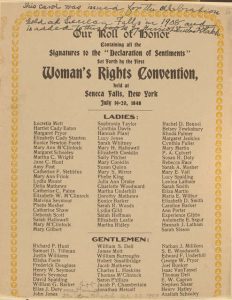Introduction – Declaration of Sentiments
In 1848, hundreds of delegates arrived in Seneca Falls, New York. They were there to attend the first women’s rights convention organized by women. In the lifetime since the drafting of the American Declaration of Independence, women had become increasingly unhappy with their position in the new republic. The ideals espoused in that document clashed with American coverture law – inherited from British common law – which placed married women as legal dependents to their husbands and therefore limited their rights to property and a vote.
The ink had not dried on either the Declaration of Independence (1776) or the Declaration of the Rights of Man and Citizen (1789) before American and French women began to raise concerns about how the so-called universal emancipatory language would be applied. Indeed, even before the American Declaration was penned, future First Lady Abigail Adams wrote to her husband John asking him to “remember the ladies” and cautioning him about what was at stake:
“Do not put such an unlimited power into the hands of the husbands. Remember, all men would be tyrants if they could. If particular care and attention in not paid to the ladies, we are determined to foment a rebellion, and will not hold ourselves bound by any laws in which we have no voice or representation” (March 31 1776)
In France, Olympe de Gouges held similar sentiments. Shortly after the National Assembly’s Declaration of Rights began to circulate, she released her Déclaration des droits de la femme et de la citoyenne. In seventeen articles that mirrored the 1789 text, de Gouges’ document sought to call attention to those people left out of the revolution’s emancipatory claims.
Though framed here as a response to the way that patriarchy and misogyny were built into the Age of Revolutions, the men and women who gathered at Seneca Falls in 1848 were also motivated by the rising movement to abolish slavery. Like Olympe de Gouges – who similarly advocated for abolition – women found a political voice, setting a context upon which meetings like the Seneca Falls Convention could take place.
This document is a complete account of the meetings during which the Declaration of Sentiments was adopted. As you read through it, give consideration to the following questions:
- What was the place of women in the early nineteenth-century United States?
- What hopes are expressed about the future place of women in the United States?
- What relationship does this Declaration have to the Declaration of Independence and the Declaration of the Rights of Man and Citizen?

This module was last edited in December 2021.

